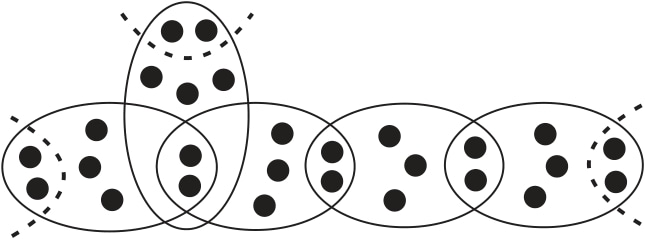The Wiener index \(W(G)\) of a graph \(G\) is defined as the sum of distances between its vertices. A tree \(T\) generates \(r\)-uniform hypergraph \(H_{r,k}(T)\) by the following way: hyperedges of cardinality \(r\) correspond to edges of the tree and adjacent hyperedges have \(k\) vertices in common. A relation between quantities \(W(T)\) and \(W(H_{r,k}(T))\) is established.
It was introduced as a structural descriptor for tree-like molecular graphs [1]. Details on the mathematical properties and chemical applications of the Wiener index can be found in books [2, 3, 4, 5, 6, 7] and reviews [8, 9, 10, 11, 12, 13]. A number of articles are devoted to comparing of the index of a graph and its derived graphs such as the line graph, the total graph, thorny and subdivision graphs of various kind (see, for example, [14, 15, 16, 17]). Hypergraphs generalize graphs by extending the definition of an edge from a binary to an \(r\)-ary relation. Wiener index of some classes of hypergraphs was studied in [18, 19, 20]. Chemical applications of hypergraphs were discussed in [21, 22].
Define a class of \(r\)-uniform hypergraphs \(H_{r,k}(T)\) induced by \(n\)-vertex trees \(T\). Edges of a tree correspond to hyperedges of cardinality \(r\) and adjacent hyperedges have \(k\) vertices in common, \(1 \leq k \leq \lfloor r/2\rfloor\). Examples of a tree and the corresponding hypergraph are shown in Figure 1. The number of vertices of \(H_{r,k}(T)\) is equal to \((n-2)(r-k)+r\). We are interesting in finding a relation between quantities \(W(T)\) and \(W(H_{r,k}(T))\).

Theorem 1. For the induced hypergraph \(H_{r,k}(T)\) of a tree \(T\) with \(n\) vertices, $$ W(H_{r,k}(T)) = (r-k)^2\,W(T) + n\binom{k}{2} – (n-1)\binom{r-2k+1}{2}. $$
This result may be useful for ordering of Wiener indices of hypergraphs. If \(r\) and \(k\) are fixed, then the ordering of the Wiener index of induced hypergraphs \(H_{r,k}\) for \(n\)-vertex trees is completely defined by the ordering of the index of trees. In particular, $$ W(H_{r,k}(S_n)) \le W(H_{r,k}(T)) \le W(H_{r,k}(P_n)) $$ for any \(n\)-vertex tree \(T\), where \(S_n\) and \(P_n\) are the star and the path with \(n\) vertices, $$ W(H_{r,k}(S_n)) = \big( r(n-1)[2n(r – 2k) + 8k – 3r – 1] + k(n-2)[k(2n-3)+1] \big) /2, $$ $$ W(H_{r,k}(P_n)) = n(r-k)[(r-k)n^2 + 10k -4r-3]/6 + 2k^2-k(2r+1)+ r(r+1)/2. $$Lemma 2. Let \(T_{e_1}, T_{e_2}, \dots , T_{e_{n-1}}\) be trees obtained by subdivision of edges \(e_1, e_2, \dots, e_{n-1}\) of \(n\)-vertex tree \(T\) with subdivision vertices \(v_1, v_2, \dots , v_{n-1}\), respectively. Then $$ d_{T_{e_1}}(v_{1}) + d_{T_{e_2}}(v_{2}) + \dots + d_{T_{e_{n-1}}}(v_{{n-1}}) = 2W(T). $$
Proof. Let \(v\) be the subdivision vertex of edge \(e=(x,y)\) of a tree \(T\). Denote by \(V_x\) and \(V_y\) the sets of vertices of two connected components after deleting edge \(e\) from \(T\) where \(x \in V_x\) and \(y \in V_y\). Since \(d_T(x)=d_T(x,V_x) + |V_y| + d_T(y,V_y)\) and \(d_T(y)=d_T(y,V_y) + |V_x| + d_T(x,V_x)\), \(d_T(x,V_x) + d_T(y,V_y) = (d_T(x) + d_T(y) – n)/2\). Then \begin{eqnarray*} d_{T_e}(v) & = & \sum_{u \in V_x} [\,d_{T_e}(v,x) + d_{T}(x,u)\,] + \sum_{u \in V_y} [\,d_{T_e}(v,y) + d_{T}(y,u)\,] \\ & = & d_T(x,V_x) + d_T(y,V_y) + n = (d_T(x) + d_T(y) + n)/2. \end{eqnarray*} Klein et al. [23] proved that \(\sum_{v \in V(T)} \deg(v) d_T(v) = 4W(T) – n(n-1)\) for an arbitrary \(n\)-vertex tree \(T\). Then \begin{eqnarray*} 2\sum_{i =1}^{n-1} d_{T_{e_i}}(v_i) & = & \sum_{(x,y) \in E(T)} (d_T(x) + d_T(y) + n) \\ &= & \sum_{v \in V(T)} \deg(v) d_T(v)+n(n-1) = 4W(T). \\[-10mm] \end{eqnarray*}
For convenience, we assume that pendent hyperedges are also adjacent with fictitious hyperedges shown by dashed lines in Figure 2. Denote by \(B_i\), \(i=1,2,\dots n\), the vertices of a hypergraph \(H=H_{r,k}(T)\) belonging to hyperedge intersections and let \(A = V(H) \setminus B_1 \cup B_2 \cup \dots \cup B_n\). We assume that edge \(E_i\) of the induced hypergraph corresponds to edge \(e_i\) of the source tree \(T\), \(i=1,2,\dots ,n-1\). Let \(d_G(U)=\sum_{u\in U} d_G(u)\) for \(U \subseteq V(G)\). Then the Wiener index of \(H\) can be represented as follows:
